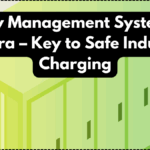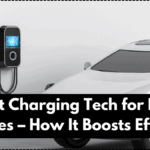Solar EV Chargers are transforming industrial sustainability in 2025. As the demand for clean energy and electric vehicle infrastructure grows, industries are embracing solar-powered charging systems as a viable, long-term solution. The introduction of these systems by companies like Shakti HiTech has not only reduced dependence on the grid but also delivered impressive cost savings and carbon reduction.
Built specifically for large-scale industrial environments, Solar Charging setups offer uninterrupted power for electric fleets and equipment. With Green Infra becoming a top priority, these chargers represent a significant move toward energy independence and eco-friendly manufacturing.

What Are Solar EV Chargers?
Solar EV Chargers use solar panels to convert sunlight into electricity, which is then stored in battery banks or fed directly into EVs. These systems are paired with smart controllers, inverters, and real-time energy management tools to ensure efficient and safe charging.
Industries can now operate their EV fleets using 100% renewable energy, thanks to the innovation in Green Infra and scalable solar solutions.
Key benefits include:
-
Reduced electricity costs
-
Lower carbon footprint
-
Independence from grid power outages
-
ROI within 3–4 years
These systems are particularly valuable for factories operating in regions with high solar potential.
Comparison of Industrial Solar EV Chargers
Here’s a breakdown of various industrial-grade Solar EV Chargers launched in 2025:
| Model | Solar Capacity | Charging Ports | Storage Option | Ideal Industry Use |
|---|---|---|---|---|
| Shakti ChargePro 15KW | 15 kW | 4 | Battery Bank | Light manufacturing units |
| SunVolt Max 25KW | 25 kW | 6 | Hybrid System | Warehouses & logistics |
| EcoGrid Ultra 40KW | 40 kW | 8 | Grid-tied only | High-volume factories |
These models reflect how Solar Charging is being tailored to meet the diverse demands of small to large-scale industrial users.
Deployment by Shakti HiTech and Industry Use Cases
Shakti HiTech has rolled out a series of solar-powered Solar EV Chargers across major industrial parks in Maharashtra, Gujarat, and Karnataka. The installations are being used in:
-
Battery-operated forklifts and loading trucks
-
In-house EV staff transport vehicles
-
Delivery fleet hubs with round-the-clock charging needs
-
Smart warehouses integrating Green Infra automation
The use of Solar Charging is not just about saving on electricity bills—it’s about building a resilient and sustainable energy system that supports continuous operation.
Economic & Environmental Impact
Switching to Solar EV Chargers offers strong economic benefits. Most systems break even within 3–4 years and continue generating savings for over a decade. Additionally, companies reduce their carbon emissions, aligning with international sustainability standards.
Key ROI Highlights:
-
Up to 70% savings on monthly energy bills
-
100% depreciation claim in the first year under energy-saving incentives
-
Over 20 tonnes of CO₂ reduction annually for medium-scale users
This fusion of economics and sustainability makes solar-based Green Infra a priority investment for forward-thinking industries.
Conclusion
With the successful rollout of Solar EV Chargers, Indian industries are making substantial progress in green mobility and sustainable infrastructure. From warehouses to manufacturing plants, solar-powered EV charging is proving to be cost-effective, efficient, and future-ready. Backed by leaders like Shakti HiTech, Solar Charging is driving real change across industrial India. Now more than ever, adopting Green Infra is not just a choice—it’s a business advantage.
FAQs
How do Solar EV Chargers help reduce industrial electricity costs?
Solar EV Chargers use free solar energy, reducing reliance on the grid and cutting electricity bills by up to 70%.
Are solar charging systems suitable for large factories?
Yes, industrial-grade systems like EcoGrid Ultra and SunVolt Max are specifically designed to support high-demand environments with 6–8 charging ports.
Is there any maintenance required for solar EV charging?
Minimal. Routine cleaning of panels and occasional inverter checks ensure smooth operation of your Solar Charging system.
Can solar chargers be integrated with existing Green Infra?
Absolutely. These chargers are compatible with existing Green Infra such as rooftop solar, battery storage, and smart grid systems.
What kind of return on investment can industries expect?
Most industrial users recover their investment within 3–4 years, thanks to savings on energy bills and tax incentives.
click here to learn more



